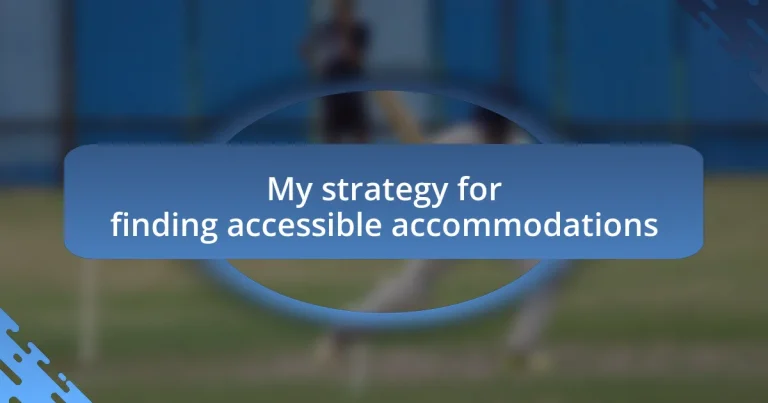Key takeaways:
- Accessible accommodations should be thoughtfully designed beyond basic features, considering elements like room layout and fixture height.
- Identifying personal accessibility needs involves reflection on comfort in various environments and proactive communication with providers.
- Effective research strategies include using specialized search engines, reading detailed reviews, and connecting with online communities for real-life insights.
- Evaluating common areas and additional amenities is essential, as accessibility should extend beyond just the individual room.
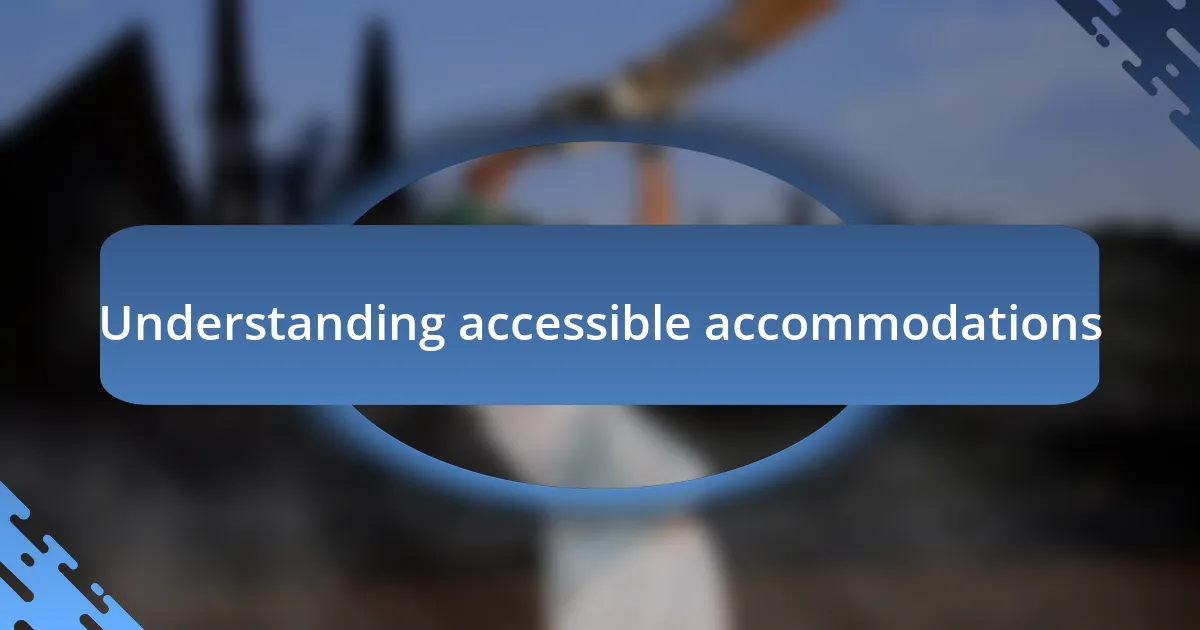
Understanding accessible accommodations
Accessible accommodations are spaces designed to be usable by individuals with various disabilities, ensuring equal access and comfort. I recall a time when I was searching for a hotel for a family trip and found myself navigating through a series of frustrating listings. Wouldn’t it be easier if accessibility information was clearer and more prominent?
It’s essential to understand that accessible accommodations go beyond just having ramps or wider doorways. I once stayed in a place that had grab bars in the bathroom, but they weren’t installed in a helpful manner. It made me realize that thoughtful design elements, like the height of fixtures and the layout of rooms, can truly enhance the experience for guests with accessibility needs.
Moreover, being aware of the different types of accessibility features is crucial. When booking a vacation rental, for instance, I often ask specific questions about accessibility options. Have you ever felt uncertain about a place’s accommodations? Knowing what to look for—like roll-in showers or lipless thresholds—can make a massive difference in ensuring a comfortable stay.

Identifying your accessibility needs
When it comes to identifying your accessibility needs, personal reflection is key. I remember planning a trip and sitting down to evaluate what specific accommodations would make my experience easier. It wasn’t just about wheelchair access; it involved considering features like lighting, sound levels, and even the type of furniture in the space. What I found was that by taking the time to assess my own needs, I felt more empowered in my lodging decisions.
Another essential aspect is understanding your own comfort levels in various environments. During a previous travel experience, I was placed in a room with an open concept that didn’t provide any visual barriers. As someone sensitive to distractions, I quickly realized that this layout was not ideal for me. Have you ever thought about how layout affects your comfort? Recognizing these subtle preferences can ensure a more enjoyable stay.
Finally, engaging directly with accommodation providers can be incredibly revealing. I once called a hotel to inquire about their features and discovered they had adjustable furniture and an extensive support system that wasn’t listed online. That conversation opened my eyes to how proactive communication can lead to better choices. Trust me, speaking up can transform your travel experience into one that truly meets your needs.
| Type of Accessibility Need | Example |
|---|---|
| Physical Access | Ramps, elevators, wide doorways |
| Visual Accessibility | High-contrast signage, tactile paths |
| Auditory Accessibility | Visual alarms, sound-proof rooms |
| Cognitive Accessibility | Clear instructions, familiar layouts |
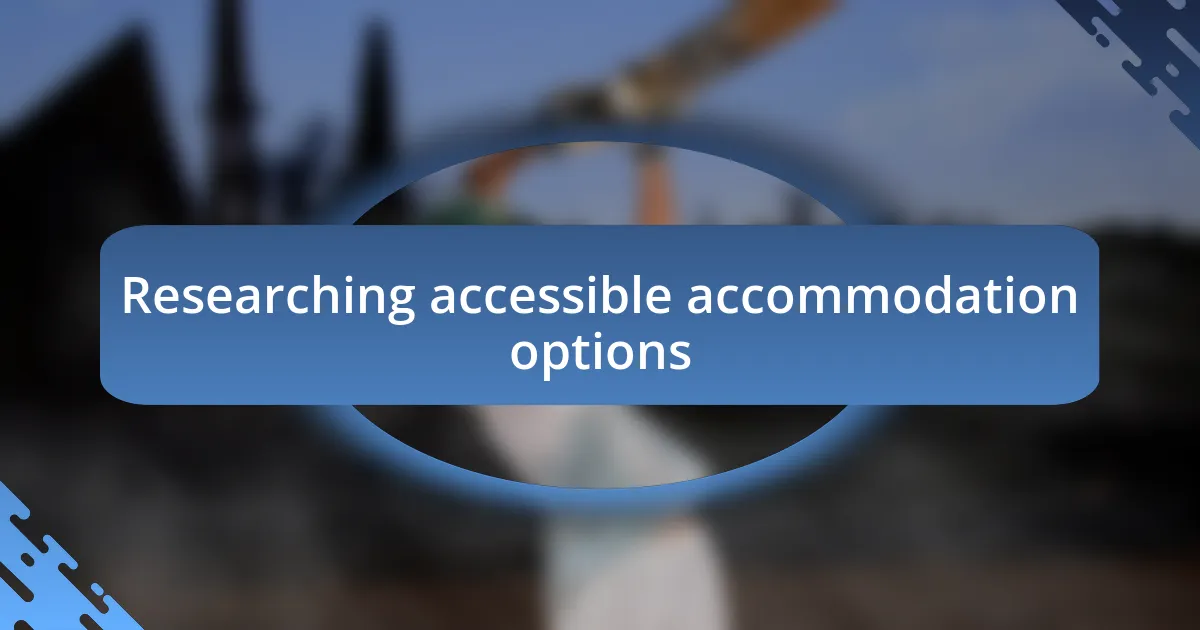
Researching accessible accommodation options
When researching accessible accommodation options, I often turn to online platforms that specialize in accessibility ratings and reviews. I remember a time when I found a gem of a hotel just because I took the extra step to read through guest feedback. Also, searching dedicated websites that focus on accessibility can reveal vetted options that may not pop up in standard search engines. This proactive approach can truly enhance your travel strategy and ensure that you find accommodations that align well with your needs.
Here are some strategies I’ve found effective in my research:
- Use specialized search engines: Websites like AccessNow or Airbnb’s accessible filter can help you find suitable options.
- Read reviews attentively: Look for specific mentions of accessibility features from previous guests.
- Connect with online communities: Platforms like forums on Facebook or Reddit can provide real-life recommendations and experiences.
- Contact accommodations directly: I’ve often received more personalized insights by speaking to a staff member about specific needs.
- Look for visual resources: Sometimes, video tours can give you a better sense of space and accessibility features than still images.
By utilizing these methods, I’ve been able to feel more confident in my booking decisions and ensure my travel experiences are as enjoyable as possible.
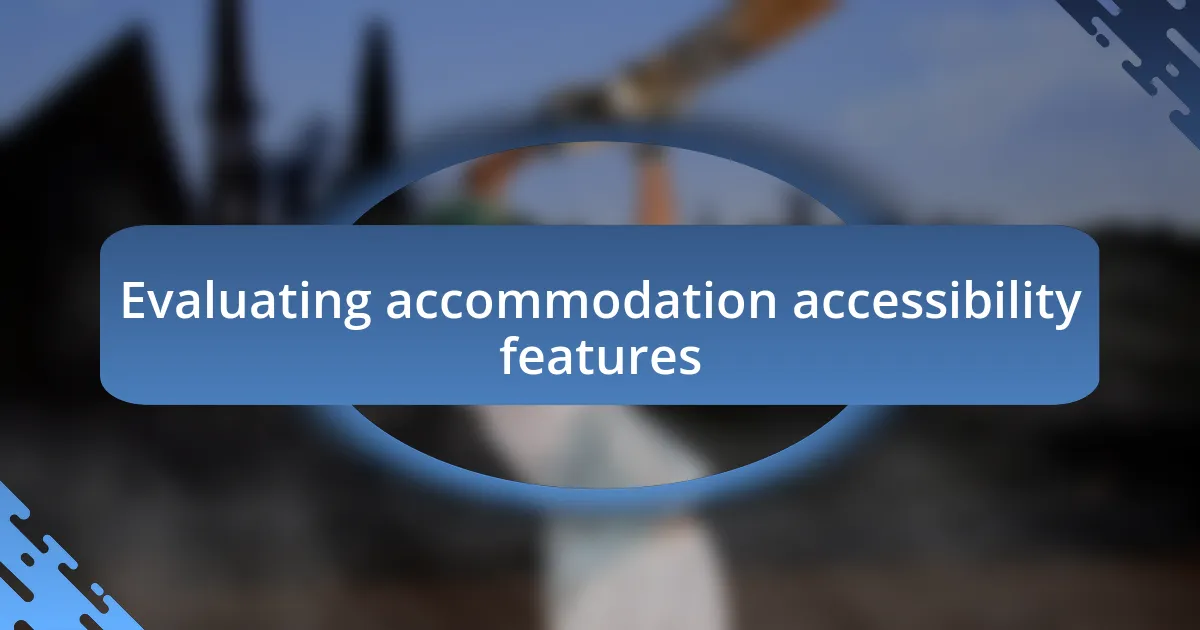
Evaluating accommodation accessibility features
When it comes to evaluating accommodation accessibility features, I instinctively look for details that genuinely impact my comfort. For instance, during one trip, I found a place that boasted wide doorways and roll-in showers, and honestly, those seemingly small details made a huge difference in my overall experience. It’s essential to ask yourself: How will these features affect my daily routine while I’m staying there?
In my experience, it’s crucial to pay attention to the accessibility of common areas, too. I once booked a hotel that offered accessible rooms, but the dining area was a challenge to navigate. It was frustrating because while my room was spacious, I often felt limited by the layout of the common spaces. That’s why I always advocate for checking out the layout of the entire accommodation, not just the room.
Consider how sound insulation or proximity to amenities can enhance your stay as well. When I stayed at a well-rated hotel near a bustling city center, I was thrilled with the accessible features, but the noise from the street made me reconsider my choice for a future visit. The comfort of a peaceful environment can’t be underestimated in the quest for accessibility. Evaluating these aspects helps ensure that your accommodations truly accommodate you.
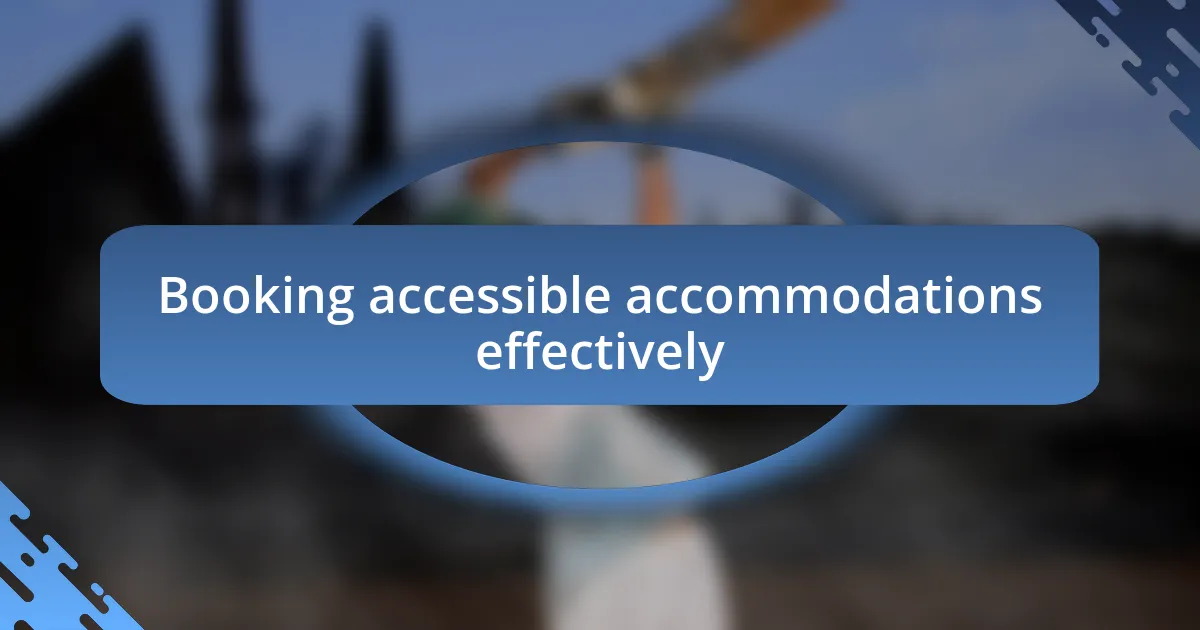
Booking accessible accommodations effectively
Booking accessible accommodations effectively requires thorough research. When I book a place, I often make a list of must-have features. Once, I overlooked the importance of accessible transportation options; while the hotel was perfect, getting around the city was a hassle without nearby public transit.
Communication is key during the booking process. When I inquire about accessibility features, I find it helpful to speak with a staff member who understands my needs. During a trip last year, I called ahead to confirm that the promised amenities were in place. That conversation opened my eyes to additional resources the hotel offered, which enhanced my stay.
I also look for user-generated reviews specifically mentioning accessibility. They reveal real-life experiences from fellow travelers and help me gauge whether a place truly lives up to its promises. I remember reading a review about a property where the accessible bathroom was often praised, which ultimately influenced my decision to book. This approach ensures I’m not just relying on marketing language but on genuine feedback from others who share similar needs.
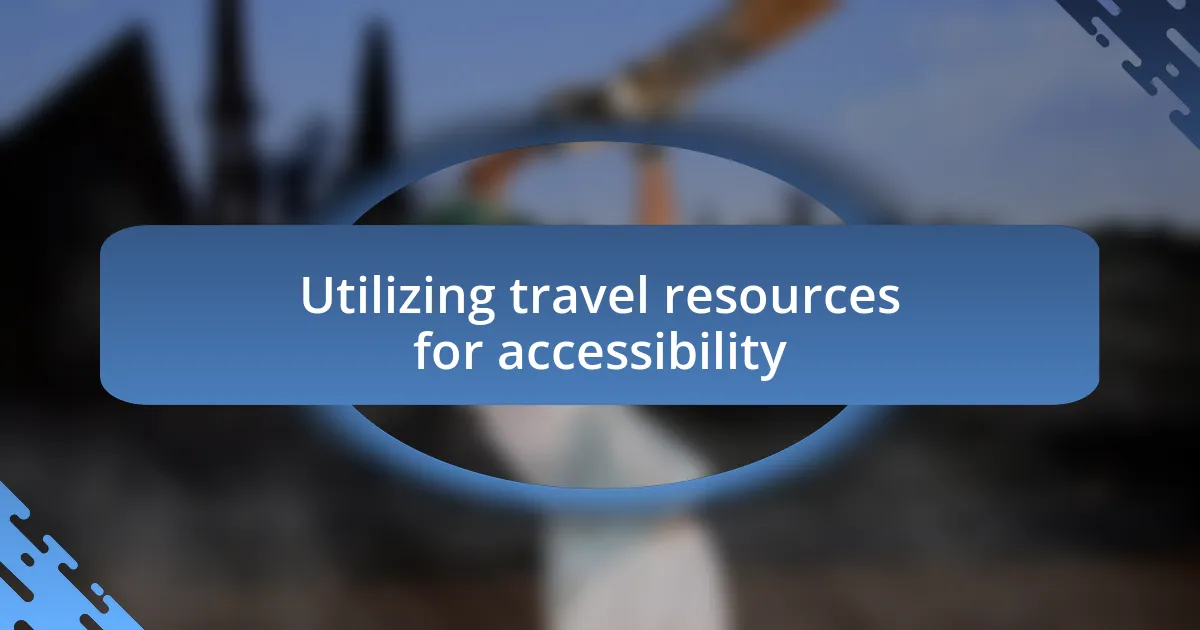
Utilizing travel resources for accessibility
Utilizing travel resources for accessibility can make a significant difference in your travel experience. For instance, I often turn to specialized travel websites that cater specifically to individuals needing accessible accommodations. One time, I found a gem of a platform that not only listed properties with accessible features but also included detailed descriptions from users about the practicality of those features. It felt reassuring to read firsthand accounts rather than just promotional text.
Another resource I commonly use is social media groups focused on travel accessibility. Joining these communities has been a game changer for me. I remember posting about my search for a hotel in a foreign city and was flooded with recommendations from members. Their insights included tips on navigating public transport and local attractions that were also accessible, which significantly enriched my trip.
Lastly, I can’t emphasize enough the importance of reaching out directly to accommodations. I often send an email or make a quick phone call to ensure that specific accessibility features will be available. A few years back, I contacted a hotel about their wheelchair accessibility and found out they were in the process of upgrading their facilities. This proactive step allowed me not only to secure my booking but also to learn about future enhancements that would benefit many travelers. Isn’t it empowering to take charge of your travel plans like that?
